In discussion with Rolf-Dieter Heuer
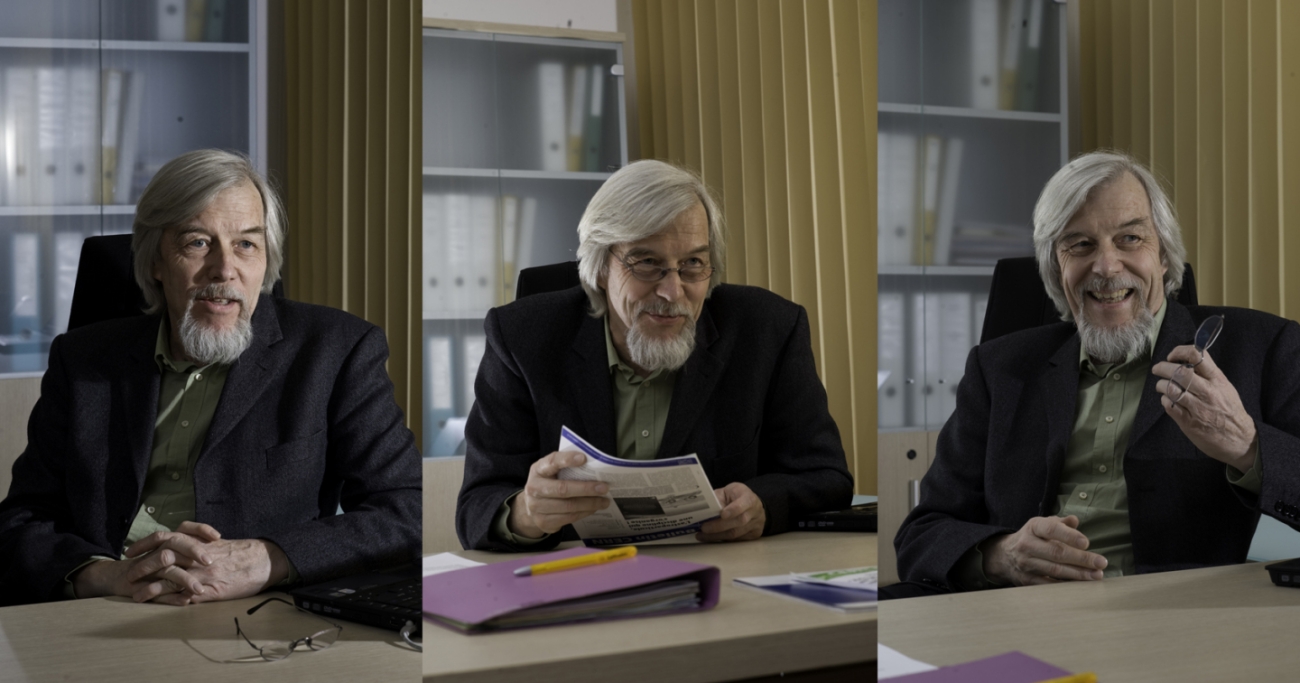
Rolf-Dieter Heuer is no stranger to CERN, serving as Director General of the organization from 2009 to 2015. Previous to that, from 1984 to 1998, he was a staff member at the Laboratory, working for the OPAL collaboration at the Large Electron Positron collider (LEP) while between 1994 and 1998, he was the collaboration’s spokesman. Much of his career has been involved with the construction and operation of large particle detector systems for studying electron-positron collisions. On leaving CERN in 1998, he took up a professorship at the University of Hamburg while in 2004 he took up his appointment as Research Director for particle and astroparticle physics at DESY. Professor Heuer was responsible for research at the HERA accelerator, DESY’s participation in the LHC. Professor Heuer has been a member of many scientific committees and advisory bodies where he acquired much expertise in reviewing projects as well as in judging and promoting people. As a research director at DESY he initiated the restructuring and focusing of German particle physics at the energy frontier with particular emphasis on the LHC. We met him just before the restart of the LHC for Run3 and the celebration of the 10th anniversary from the Higgs boson discovery. Given the challenges faced and still to come, we discuss the discoveries in sight and the open questions that remain, this promises to be one of the most exciting periods in the life of the laboratory and in particle physics in general. In the interview, we reflect on the scientific results from LEP and the LHC and their potential huge impact on the future of CERN but also, potentially, the future of particle physics world-wide.
For Rolf Heuer, one of the fascinating facts that attracted him in studying physics is the universality of scientific laws. “One of the attractive things about physics is that a certain series of logical steps lead to universal laws, applying beyond geographical borders and even beyond our planet”. Heuer recalls that as a student “I was not particularly good in memorizing numbers but rather focusing on the process of understanding the underlying principles that could give me the right answer to a problem”. It was thanks to one of his high-school physics teachers, who encouraged them to perform hands-on experiments and measure results instead of trusting a written formula. As an example, Heuer refers to the Millikan experiment, performed almost a century ago, in 1909 by Robert Millikan and Harvey Fletcher to determine the charge-to-mass ratio (e/m) of the electrons. “We were asked to repeat this experiment in our classroom and determine a precise value for the electric charge of the electron while also elegantly demonstrating the quantisation of charge”.
His exposure to the fundamentals of the experimental method during his school years, drove Heuer’s strong interest in nuclear physics. “I wanted to explore the smallest possible particles and understand how the microcosm and consequently everything that we observe around us in nature was built up”. Soon after starting studying nuclear physics, Rolf realized that the nucleus was still too large or, as Feynman stated it, that “there is plenty of room at the bottom”. Therefore, he decided to redirect his studies to particle physics, a field that was dealing with more elementary particles while also holding an international dimension. Heuer received an offer for pursuing his PhD thesis in Heidelberg, working at DESY. “This offer came at the time of the discovery of a new particle with an unusually narrow width at 3095 MeV, known popularly as the J/Ψ, by two independent groups, one lead by Samuel Ting at Brookhaven National Laboratory (BNL) in New York and the second lead by Burton Richter at Stanford Linear Accelerator Center (SLAC) in California''. He continues “This discovery, also coined at that time as the November revolution, has been decisive in our understanding and formulating the current picture about the basic constituents of matter”. To appreciate the surprise, imagine if one suddenly discovers a new pyramid, twice as heavy as the largest one known so far and yet a thousand times narrower and thus higher!
The unprecedented large lifetime of the new particle led to a host of theoretical speculations and vigorous experimental activities. During the next year, more than seven hundred papers were written related to this discovery which was a record in physics at that time. “A number of theoretical speculations were made about what it is. The big question was, why is J/ψ so narrow and hence longlived? A particle was discovered with properties so different from those expected, that the first guesses as to what it was were largely mistaken. Soon it became evident that it was a predicted particle after all, but it so happened that its features were more exotic than was foreseen. ”. A number of theoretical interpretations were presented at that time calling for more experimental data to elucidate its nature.This was an experimental discovery requiring new twists in the theory, which we now understand very well to be a flavour neutral meson, consisting of a charm quark and a charm anti-quark. Soon after, two more discoveries were following, namely those of the tau lepton at 1786 MeV and bb bound states where b is the fifth quark. “We were assuming that there would be twelve basic constituents of nature, six leptons (τ - neutrino being the sixth lepton) and six quarks. Even though only five quarks were known till then, everyone was confident that there must exist the sixth quark and such a quark (t-quark) was indeed discovered at Fermilab twenty years later in 1994”.
But at that time an open question occupying the community was the existence and in particular the mass of the top quark. Heuer notes “Soon, after my PhD thesis, I worked for the JADE experiment on the electron-positron storage ring PETRA at DESY and the search for the top was already one of our experimental challenges. According to the theorists, it was always around the corner. However, after exhaustive scans over the whole energy range, we didn’t discover anything”. Heuer worked on the JADE experiment from 1977 to 1983. In 1984, he decided to join the OPAL experiment at CERN’s LEP, “CERN had a small group at OPAL and was looking for a coordinator of the activities towards the completion of its central detector. The detector consisted of a vertex detector (complemented by a silicon microvertex detector at a later stage), a jet chamber, and z-chambers''. During his time at CERN, Heuer coordinated the construction and design of the track chamber system and later became run coordinator in the initial phase of LEP1 1989-1992. In 1994, he was elected spokesperson for the OPAL experiment and was responsible for the entire collaboration during the analysis of the LEP1 data and the upgrade of the experiment for LEP2. Heuer recalls the first observation of the Z boson by the OPAL experiment, “it was one of the key milestones that had helped to build up the motivation among our collaborators who contributed in building and commissioning the experiment. Recording the first events was a moment of proudness but also a relief since it proved that all our subdetectors and the trigger and DAC systems were working”.
With LEP, the scale of experiments at CERN took a big leap forward, as did the degree of collaboration between them. According to Heuer, “team collaboration is the cornerstone of any successful scientific endeavor, a lesson that I tried to carry forward also as CERN’s Director General. Building a collaboration takes a concerted effort to integrate co-operative values as well as developing a sense of ownership among the members of your collaboration”. From operating as independent entities before LEP switched on in 1989, they went on to develop common working groups on many physics topics. And when LEP switched off in 2000, it was these working groups that had the last word. It's a model that works well. Sharing best practice and combining results delivers the best physics in the long run while not compromising the healthy spirit of competition that exists between the experiments and which is still alive at the LHC. Moreover, it is important to attract young colleagues who bring in fresh ideas and a different perspective: “this was one of the characteristics of OPAL who had many young fellows. We tried to provide a flexible collaborative structure that would nurture their creativity while also enabling them to get the best out of their skills”.
LEP experiments tested the validity of the Standard Model (SM) of Particle Physics at an unprecedented level of precision. In its first phase of operation from 1989 to 1995, electrons and positrons collided in LEP at 91 GeV, to produce Z bosons. For Heuer, “OPAL accumulated millions of these Z events for high-precision measurements and this is one of its greatest legacies in particle physics. The accuracy with which LEP pinned down the properties of the Z boson, remains unsurpassed to this day. This includes the Z decay to invisible particles, its invisible width and branching fraction, which were used to deduce that there are three (and only three) species of light neutrinos that couple to the Z boson”.
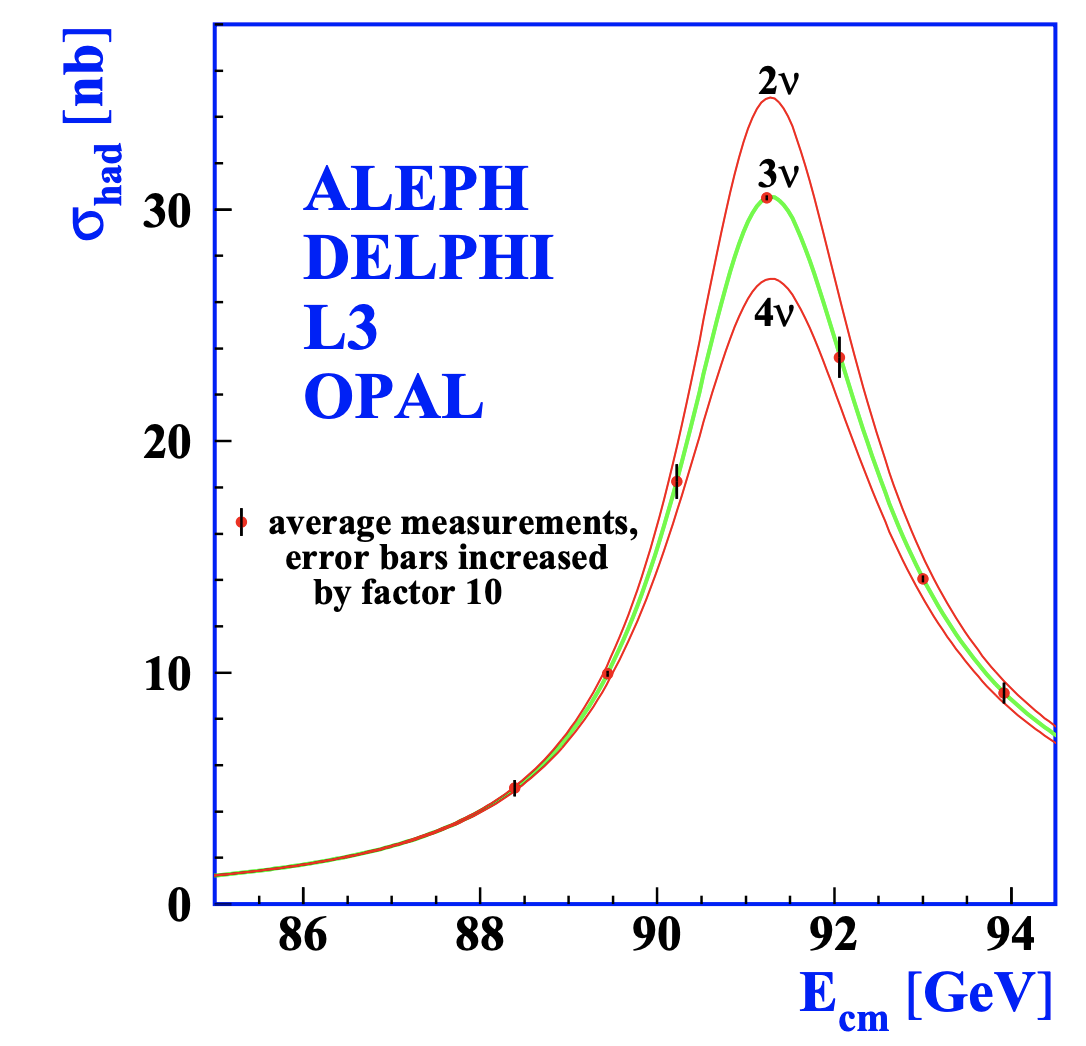
Measurements of the hadron production cross-section around the Z resonance. The curves indicate the predicted cross-section for two, three and four neutrino species with SM couplings and negligible mass. Reproduced from Ref [1].
He concludes that “LEP’s research programme is a demonstration that precision physics can show you the way forward and guide future developments in the field” and continues “take for example the top quark which we were already trying to find at PETRA. However, neither PETRA, nor LEP/LEPII had enough energy to produce couples of top/antitop pairs. Instead, through “Precision Electroweak Measurements on the Z Resonance” at LEP, it was possible to calculate values of the top mass (and weaker limits on the Higgs mass) that would be consistent with what was later found at Tevatron”. Taking into account the radiative corrections evaluated in the framework of the Standard Model, the Z-pole data lead to a prediction of the top quark mass of 173GeV+13-10 GeV.
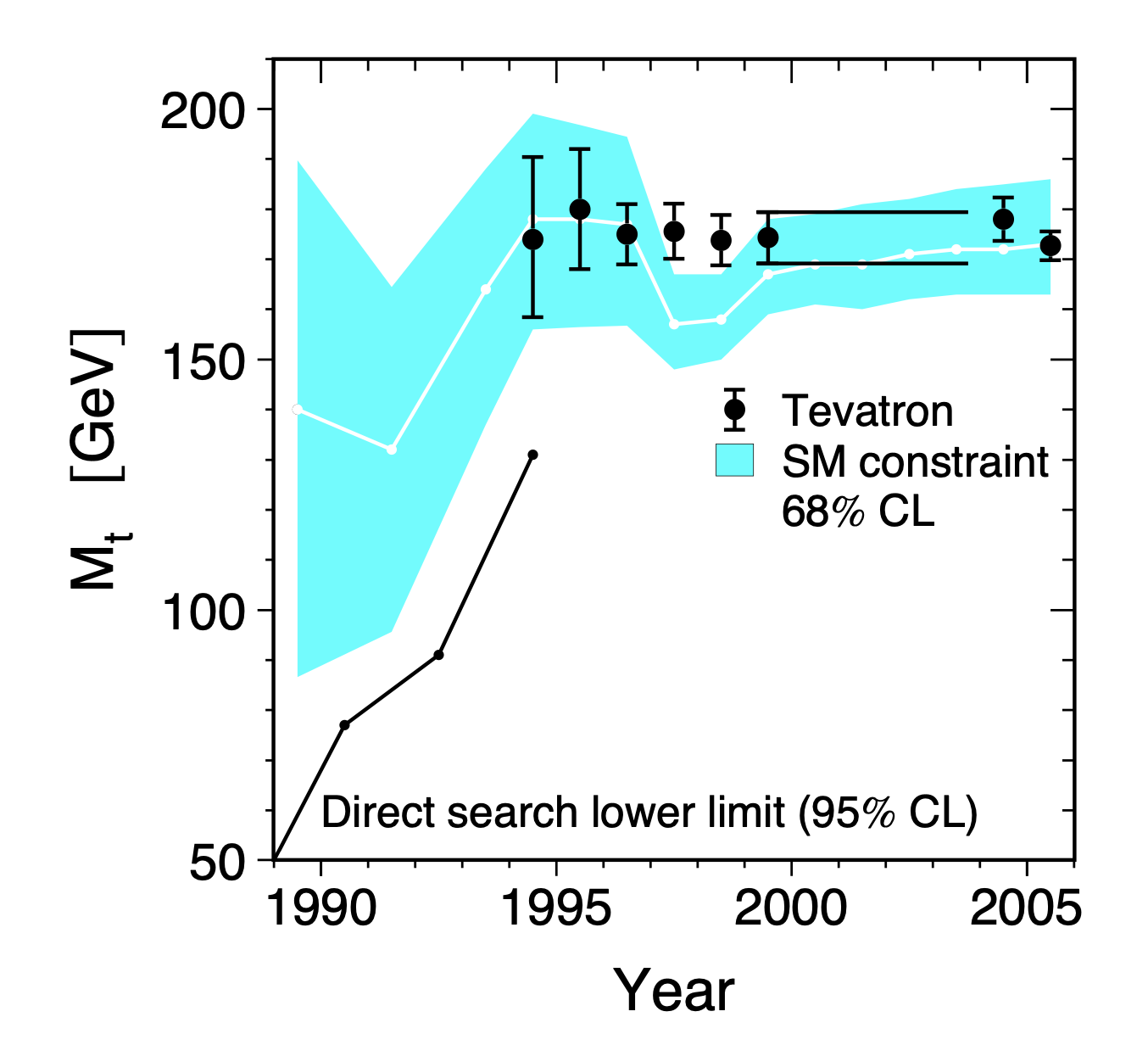
Comparison of direct and indirect determinations of the mass of the top quark, mt , as a function of time. The shaded area denotes the indirect determination of mt at 68% confidence level derived from the analysis of radiative corrections within the framework of the SM using precision electroweak measurements. The dots with error bars at 68% confidence level denote the direct measurements of mt performed by the Tevatron experiments CDF and DØ. Also shown is the 95% confidence level lower limit on mt from the direct searches before the discovery of the top quark. Predictions and measurements agree well. Reproduced from Ref [1].
Precision physics at CERN’s LEP guided future experimental searches at Tevatron in Fermilab. “Following the discovery of the top quark at Tevatron, we were also able to get better constraints on the mass of the Higgs boson. Looking back, one could argue that LEP and Tevatron worked together to shape the Standard Model of Particle Physics as we know it today, paving the way to the LHC’s discovery of its last missing cornerstone, the Higgs boson”. This is also true in today’s landscape of particle physics as Indirect precise measurements can point to the way forward to direct measurements. However, this also requires a good model that would allow us to calculate the missing pieces. For Heuer “this is one of the challenges that we presently face as there is no evidence which is the right model describing the physics beyond the Standard Model. We know from experimental evidence and theoretical considerations that there is new physics but we just don’t know which is the right model”.
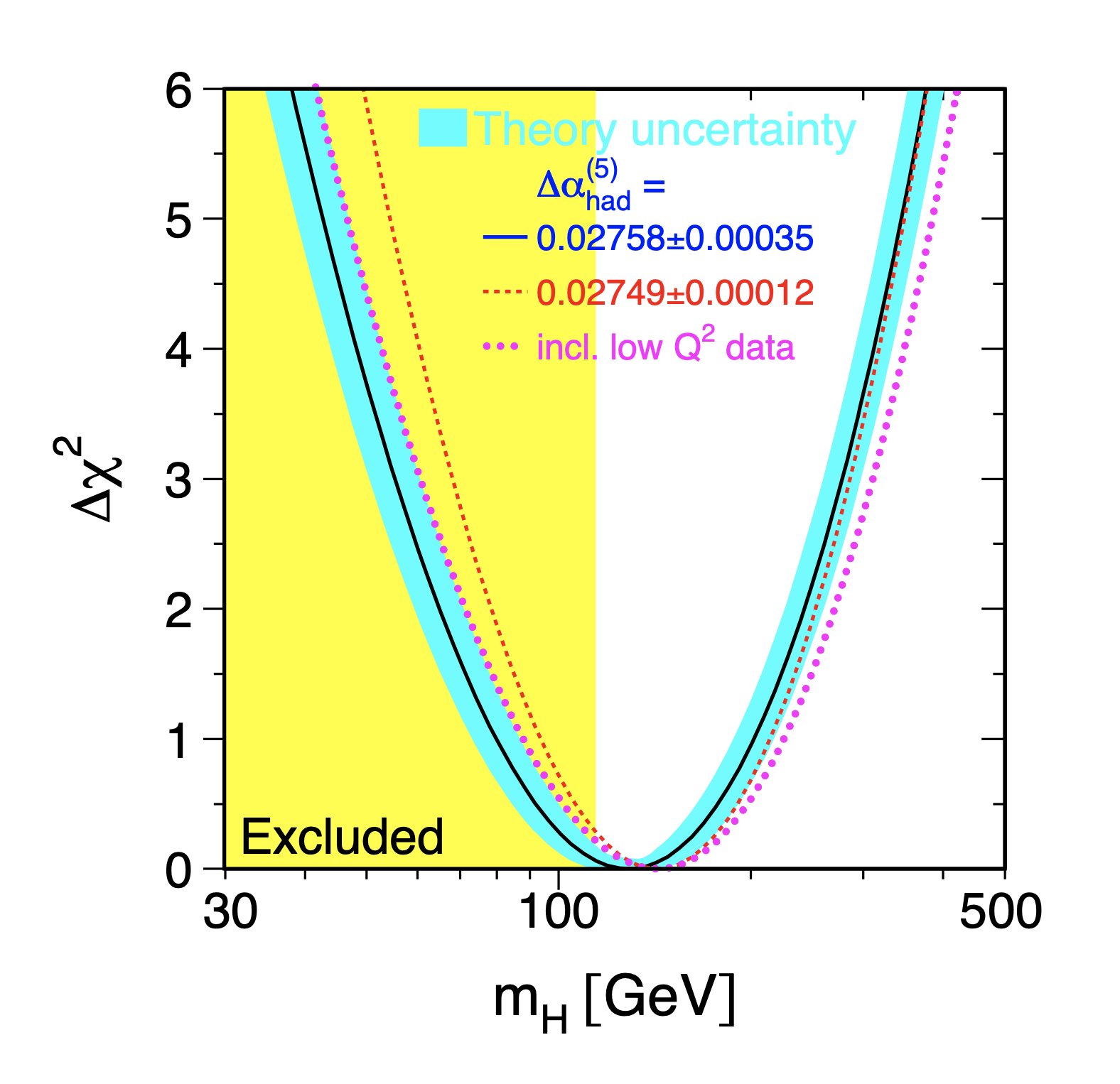
The plot shows Δχ2 (mH) as a function of mH. The line is the result of the fit using all 18 results. The associated band represents the estimate of the theoretical uncertainty due to missing higher-order corrections. The vertical band shows the 95% confidence level exclusion limit on mH of 114.4 GeV derived from the direct search at LEP-II. The dashed curve is the result obtained using the theory-driven. Reproduced from Ref [1]
Following his experience at LEP, Heuer decided to move back to DESY in Hamburg where he was appointed to a professorship at the University of Hamburg. “I thought that being a member of one experiment for fifteen years was enough and it was time to pursue a different endeavour”. At DESY, he joined the H1 experiment at the HERA and set up a working group that dealt with the preparations for a new linear electron-positron accelerator, the so-called TESLA project. “I started working under the guidance of Bjoern Wiik, a charismatic director who unfortunately died a few months laters, and continued strongly collaborating with Albrecht Wagner. In December 2004 he became Scientific Director for Particles and Astroparticle Physics at DESY. The focus of his work there was to keep DESY as the central particle physics laboratory in Germany and to strengthen the connections to the universities and CERN. In this context, the particle physics group at DESY joined the two LHC experiments ATLAS and CMS and thus aligned the laboratory towards the LHC. Rolf recalls the last years of data taking at LEP and the challenging transition from LEP to the LHC as the physics coming out of the LEP experiments was very interesting and kept attracting a lot of attention. For Heuer, the decision to terminate LEP’s operations proved to be the right one as LEP didn’t have enough energy to produce the HZ channel, however he expresses his concern on the way this decision was taken: “In my view, the biggest problem was that the experimental collaborations were not involved in the decision making process from the beginning. This would have made things much easier and allowed us to move faster and smoother”. CERN’s long record of delivering big scientific projects on schedule and on budget was pivotal for the approval and construction of the LHC. “CERN was never overpromising on what its accelerator complex can deliver and this was positively viewed by the international community and the funding agencies”. Secondly, the scientific results from LEP and specifically the wealth of precision measurements, were clearly indicating that LHC would discover something. “We never promised that the LHC would find the Higgs boson but that it could elucidate the electroweak symmetry breaking mechanism and enrich our understanding of how elementary particles get their mass”.
In December 2007, Prof. Heuer was elected Director General of CERN and officially started his mandate in January 2009. Rolf often reflects on the daunting challenge of his mission to steer the organization during a turbulent period. “I saw these challenges as opportunities that could show to everyone what CERN as an organization is capable of doing, even during difficult financial and political times”. To that end, his previous experience from the management of big science projects proved crucial. The ensuing financial crisis was followed by a looming financial environment in many European economies. “Certain countries in Europe were facing big economic problems making it hard to catch up with their financial contribution to the organization. Therefore, I decided to visit these countries and meet the funding agencies and research ministers to establish direct contacts with our shareholders”. The message that Heuer tried to convey during these meetings was that “CERN is your laboratory even if it is not in your ground”, a message that eventually went through and was also picked up by researchers, educators and the industry in most of our member states.
Following the LHC incident, Heuer took courage from two things: “The first was the spirit of determination of CERN’s staff to work and solve this issue. I could see that for the people who spent years designing and building this machine, it was a matter of pride to be able to fix it. The second was the support that CERN’s management received from CERN’s Council. The delegates didn’t put pressure on the timescale for fixing the machine. Instead the message that we got was that we should take as much time as needed, without rushing but prioritize a high-quality solution that would avoid a second failure. It was important to get this message and pass it on to the technical teams that had to be involved in the solution. Don’t forget that before any intervention we got different requirements from the vacuum group, from the magnet teams, from the power supply group and so on”. We brought everyone together and worked reasonably fast to understand the problem and find a solution.
Overcoming these problems, the LHC successfully restarted its operations later in 2009 delivering data to the four main experiments, including the ATLAS and CMS collaborations that were looking for the Higgs boson. “Following the first results that matched our simulations, we started gaining confidence that the whole infrastructure, including the machine and the experiments, work as expected and thus we could use our tools to even make predictions for what we could see”. Heuer recalls “we had a planned technical shutdown to improve the interconnections of the LHC magnets following the incident but it was delayed by a few months following a risk assessment. Based on a SWOT analysis, it was decided that the machine could run longer even with a slight increase in energy. Thanks to this decision we succeeded in discovering the Higgs boson in 2012”.
I ask Heuer how it felt to be the first one to learn about the existence of the long-sought Higgs boson? Heuer replies that he was meeting the experimental spokespersons independently, always in the presence of Sergio Bertolucci who was CERN’s Director for Scientific Research at that time. “It was clear that we had to meet them privately and understand how far they are with their analysis. Based on the results that we were shown, we decided to hold this special seminar at CERN just before the big ICHEP conference in Melbourne. When we announced the seminar, it was not yet clear if any of the two collaborations would reach a signal beyond 5σ, though the combination would certainly lead to a 5σ discovery”. For Heuer, that was a positively intense time as “it was clear that the signal was reasonably strong, on the right decay mode and the non-disappearing fluctuation was more or less at the same mass value”. On 4 July 2012, in a packed CERN’s Auditorium, Fabiola Gianotti, the ATLAS spokesperson, and Joe Incandela, the CMS spokesperson, announced that their experiments had found a particle consistent with the long sought-after Higgs boson.
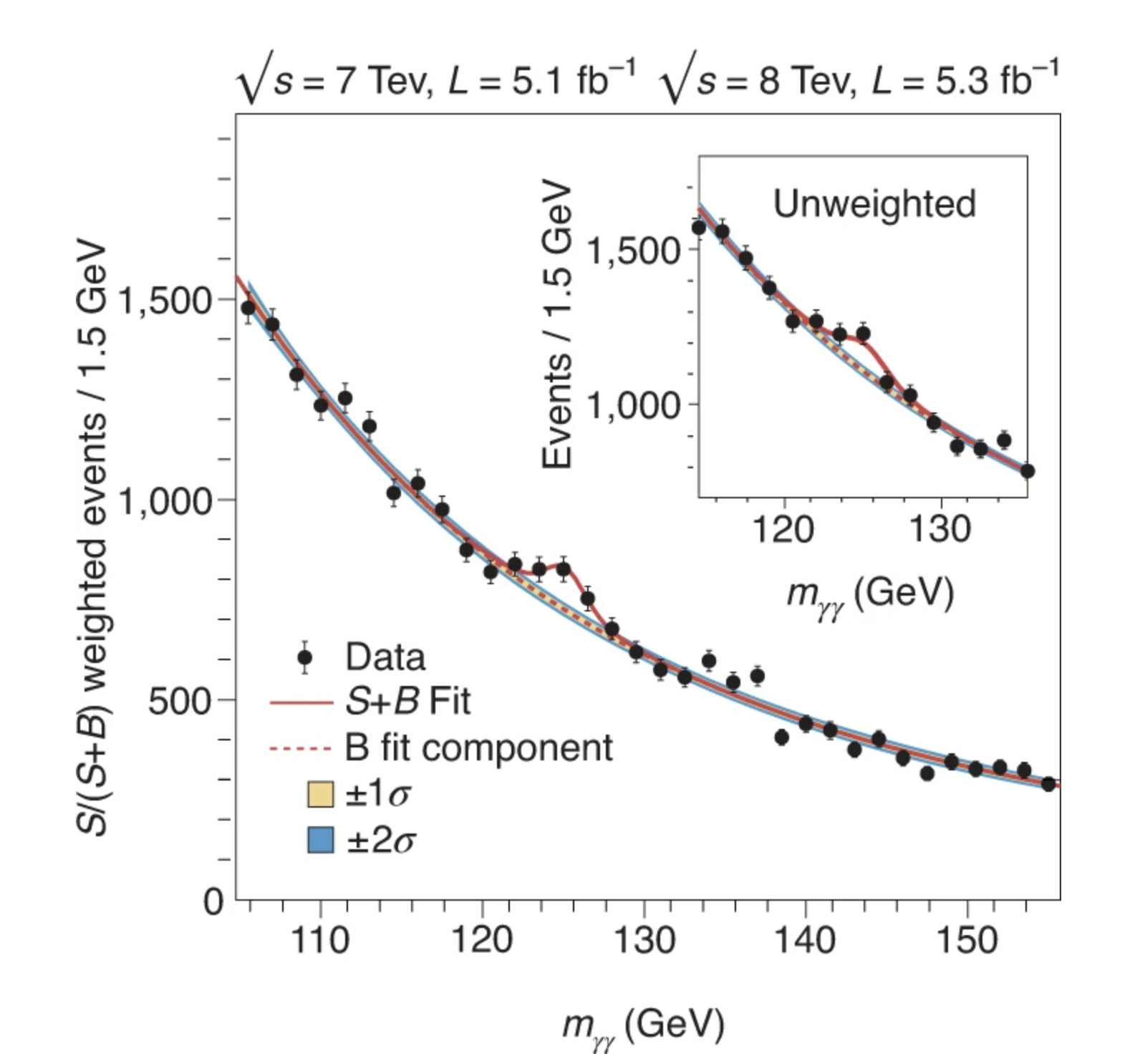
The two-photon mass distribution mγγ, similar to the one presented on 4 July by the CMS Collaboration, shows the discovery of a particle with a mass around 125 GeV in a striking way. Reproduced from Ref [2] under a Creative Commons licence CC BY 4.0
“I was very touched and very excited at the same time, to be present at such an important discovery, based on many years of work by so many people around the world. Not to mention having Peter Higgs and François Englert in the audience”. Heuer was always cautious not to overstate whether this was the Standard Model Higgs until some of its parameters were carefully measured. In this respect, he said: “as a layman I think that we got it but we don’t know what we really have. At that point one couldn’t say that we have discovered the mysterious and long-sought elementary particle. However, we didn't know for sure whether it was the one predicted by the Standard Model or an entirely new particle that looks like the Higgs at first glance. Thus, as a scientist I insisted that we should be careful and measure the properties of the particle precisely”. However, the Higgs discovery was not only a major event in science but also in science communication. “It was a media phenomenon with over 12,000 news mentions reaching billions of people around the globe. For me, it is surprising that almost ten years later, people still talk about the Higgs boson and they even remember the Higgs Nobel prize which is not the case with too many Nobel prizes”. When giving public lectures, Heuer often addresses his audience with a question “I guess you are now wondering why in hell I should be interested in the Higgs? You should, because thanks to the Higgs boson you are here”.
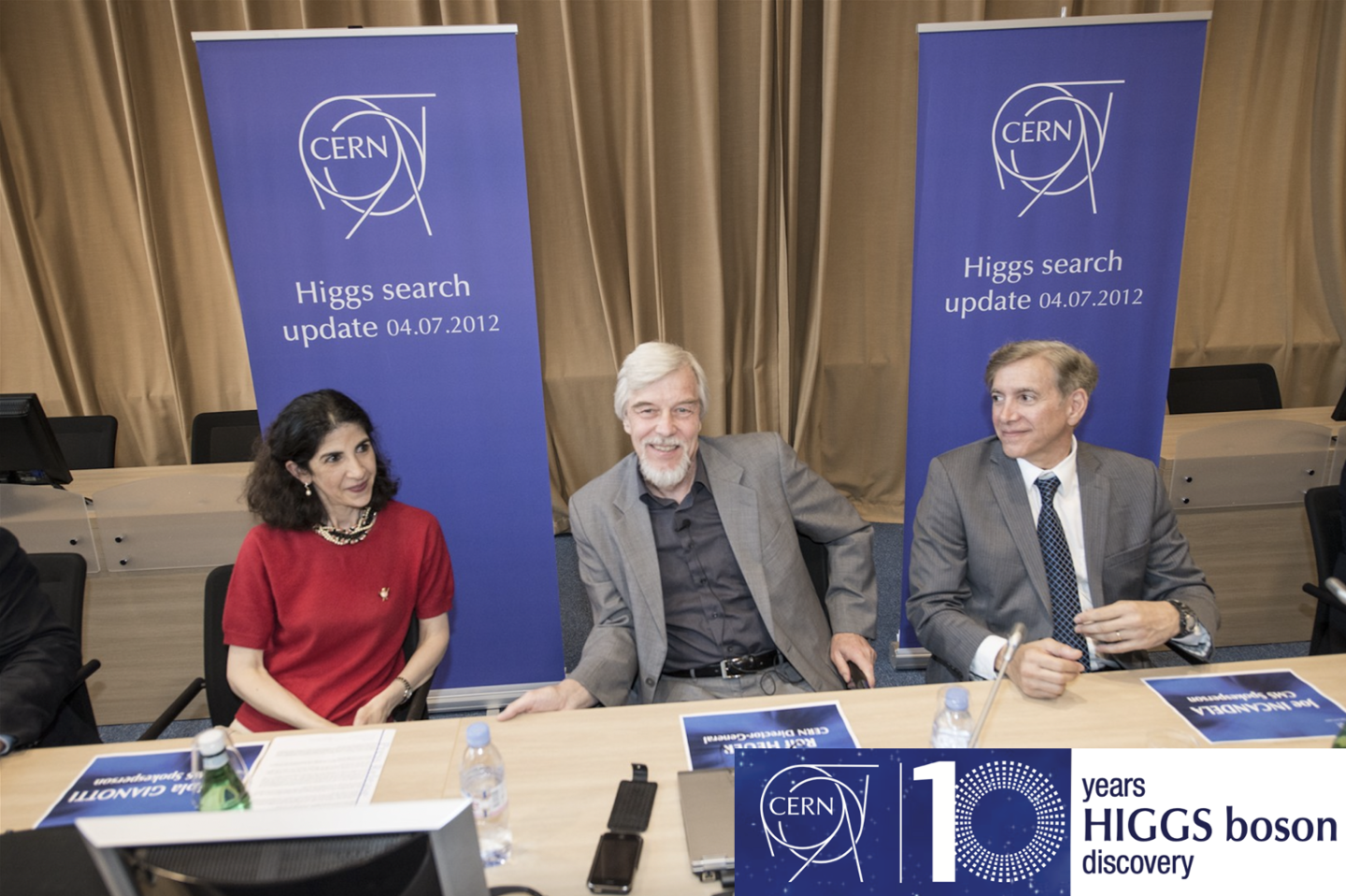
On the day of the Higgs boson announcement, with spokespersons Fabiola Gianotti, Rolf Dieter-Heuer and Joe Incandela. Credits: CERN.
Finding the Higgs is undoubtedly an impressive confirmation of the Standard Model. But there are still open questions in particle physics. “Although the Standard Model is fascinating, it is also frustrating at the same time: most of our questions remain unanswered with this model, with which we can only describe four to five percent of our universe”. How can we go hunt for these questions in the post-LHC era? Heuer shares his clear vision: “We need a more powerful accelerator that will give us better resolution. This would allow us to examine smaller and smaller areas more and more precisely. This would be possible with an accelerator in which electrons and positrons collide. The plans for this already exist and the technology is essentially ready for use. In view of the current economic crisis, however, the big question is who would be willing to finance construction and operation. The proposed FCC, that could subsequently host a lepton and a hadron collider, is only possible as a global project. In many respects we are moving at the limits of knowledge”.
To that direction, Heuer, already from the beginning of his mandate, worked for the internationalization of CERN. He was convinced that CERN should prepare for another big-science project after the LHC which in turn would require it to open up to new member states. “I firmly believed that CERN, and any scientific organization, should have steady annual contributions from member states instead of only asking for exceptional/additional resources. This approach can secure funding that is needed not only for building but also for maintaining and operating such large-scale projects. Moreover, it gives a much stronger sense of ownership which is needed for building a user community that will profit from these infrastructures”. This fact largely motivated the effort for the internationalization of CERN, “We looked closely at CERN’s convention and found that it was written very wisely, allowing room to include member states from outside Europe”. Following a resolution unanimously adopted in 2014, during the 169th session of the CERN Council, CERN admitted Israel as the Organization’s 21st Member State while today it counts 23 Member States and many more in the state of pre-membership or as associate members. Despite this momentum, Heuer admits that there is still a long way to reach the original vision for a global laboratory for particle physics. “In the past few months, my faith in this project has been restored. I believe that a global scientific laboratory could give a good signal on the power of science to bring people together, trigger their potential to build new technologies and scientific instruments to advance our knowledge about the cosmos”. Heuer often refers to the build of new collaborations as a trivial process, so I am tempted to ask him about his secret: “Key in establishing global collaborations has been openness and transparency, developing trust among people and offering them the environment for mutual exchange of ideas”.
Beyond the aspect of collaboration, there are other benefits that stem from public investment in such large-scale projects. During the interview, Heuer recalls that already from the time of HERA at DESY, there were ongoing studies trying to capture the socio-economic impact of the machine. “Today, we have a number of studies, following different methodologies, but all concluding that there are much more benefits from public investment in big science than people often realize.” Heuer explains that the benefits may not come from the direct application of our research results, which can often take decades before finding a daily application, but are linked to the scientific process and specifically the development of the needed technologies as well as the training of the next generations of researchers”. Heuer remembers that during the LEP construction, his team received an offer for a very complex piece of equipment needed for their detector. “We called them to verify that there was no mistake and the firm replied that they are more interested in the long-term profit they could have by developing this piece and mastering these new technologies'' and adds “more than a typical customer-business relation one should see this as a partnership which allows unfolding the full potential”. Heuer is also adamant on the role of training “We should not forget the brains, the young people that join and shape this endeavor of building new scientific tools. These large-scale facilities offer an excellent training ground for developing not only the hard skills related to a specific scientific or engineering field, but also soft skills of collaborating with other cultures and nationalities”. Heuer also understands that these arguments may not be so popular, especially as we are more and more used to shorter timescales in our daily activities. “It is difficult to digest this information concerning long-term projects when we need to communicate them in the daily reality of fast consuming social media. However, we need to balance between the need for fast return versus a long-term vision for the future of our society, given also the inter-generational character that most of these investments have”. Scientists, science journalists and science policy makers need to think of the benefits for present generations along with the rights of future generations and the opportunities that we will create for them.
Before closing our discussion, I ask him what might come after the Higgs boson discovery. “I think that what comes after the Higgs, it is the study of the Higgs (laughter). We have this new particle but we don’t fully understand its properties and interactions with the other known particles. We have to measure them very precisely.
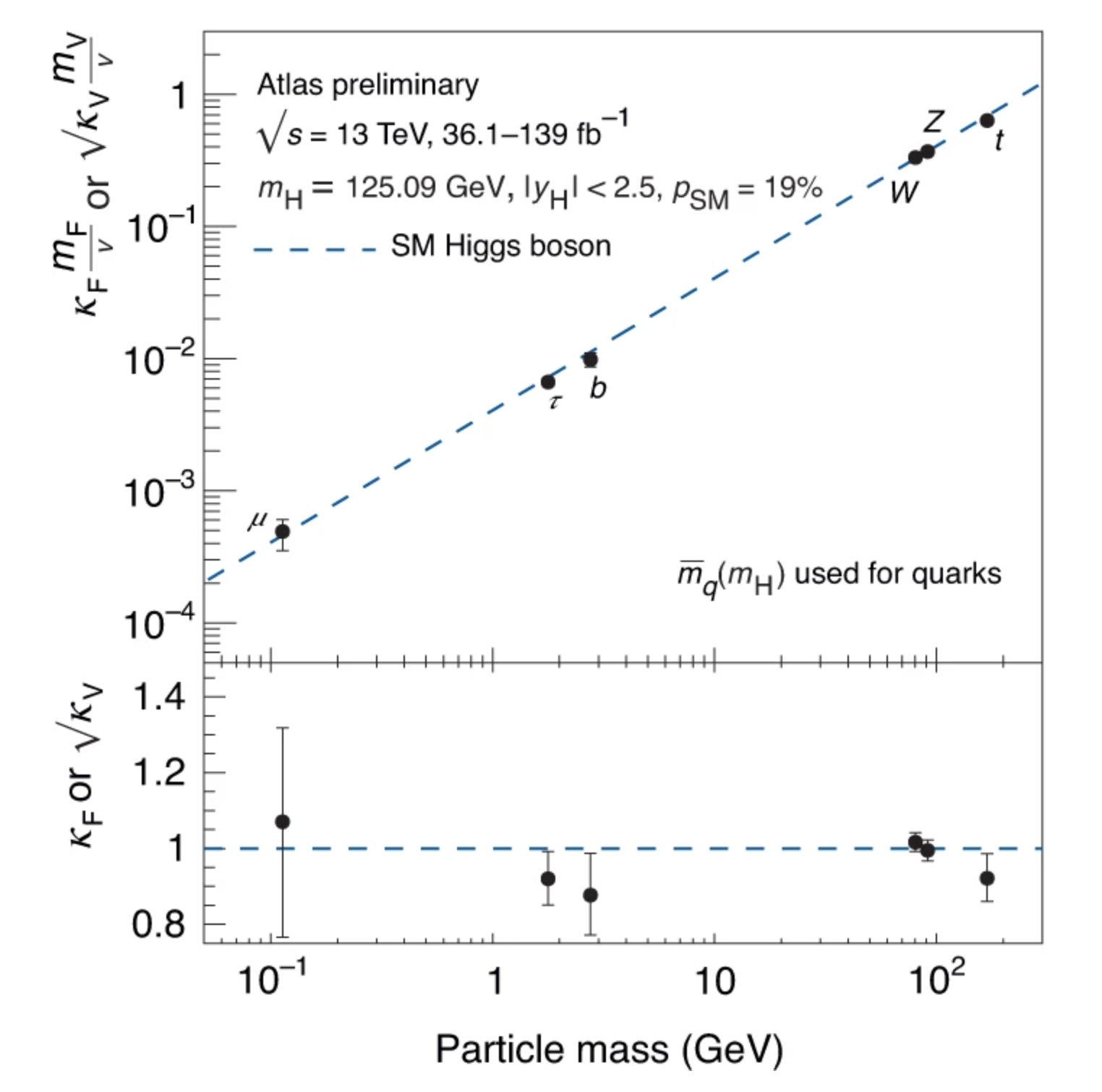
Top: measurement of the reduced coupling strength modifiers of the Higgs boson to other standard model particles — namely the top (t) and bottom (b) quarks, muon (μ), τ lepton, and W and Z bosons — by the ATLAS Collaboration. Bottom: ratio of the couplings to the standard model prediction. The values agree well within the measurement errors (68% confidence level) with the expectation from the standard model (dashed lines). The level of compatibility between experiment and standard model corresponds to a p value of pSM = 19%. Reproduced from Ref [3] under a Creative Commons licence CC BY 4.0
These precision measurements could point the way forward as at the time of LEP. The Higgs boson, is the only fundamental particle that we know today with spin zero and one may wonder whether this is really the case in nature. One can ask why there are so many particles with non zero spin and only one with spin 0”. Moreover, Heuer explains that the Higgs can be connected with other sectors beyond the Standard Model. “Measuring the properties of the Higgs boson in detail is crucial to exploring many outstanding mysteries in particle physics”. Heuer also points out the relation between theory and experiment. “Experimentalists by collecting and analyzing data can discover something new for which they will need an explanation whereas theorists, while building a mathematical consistent description of nature, have to look for a confirmation. In my opinion, for advancing in answering some of the open questions we need to foster a healthy collaboration between the two communities”.
References
[1] ALEPH, DELPHI, L3, OPAL, SLD, LEP Electroweak Working Group, SLD Electroweak Group, SLD Heavy Flavour Group, "Precision electroweak measurements on the Z resonance", Phys.Rept. 427 (2006) 257
[2] CMS Collaboration. Phys. Lett. B 716, 30–61 (2012).
[3] ATLAS Collaboration, "Combined Measurements of Higgs Boson Production and Decay Using up to 139 fb−1 of Proton–Proton Collision Data at √s = 13 TeV Collected with the ATLAS Experiment". ATLAS-CONF-2021-053 (2021).
